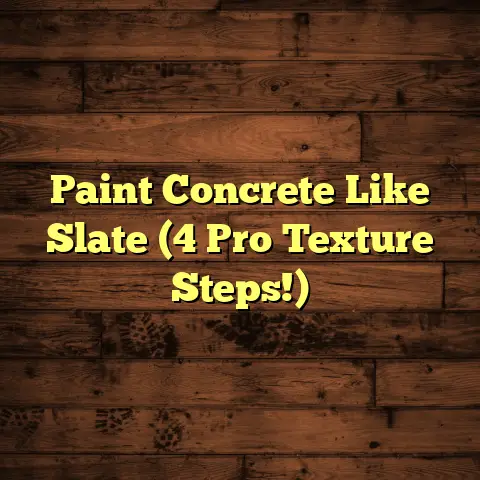Hardwood vs. Laminate Floors? (2 Choices Shock Pros!)
2 Choices Shock Pros!
Ever walk into a house and just know something’s right? Nine times out of ten, it’s the floor!
I’ve been laying floors for over 20 years, and I’ve seen it all. From shag carpets that hide lost toys for decades to gleaming marble that screams “expensive,” flooring makes a statement.
But what happens when you’re stuck between a rock and a hard place… or rather, between hardwood and laminate?
I recently met a young family, the Millers, fresh off a move into their “fixer-upper” dream home.
They were buzzing with excitement about renovating, but their smiles faded when we hit the flooring. Their vision? Warm, inviting floors that could handle kids, pets, and the occasional spilled juice box.
Their budget? Let’s just say they weren’t planning on taking out a second mortgage.
Hardwood’s timeless beauty whispered promises of elegance and value. Laminate’s practicality shouted about affordability and durability. The Millers were stuck.
And honestly? I get it. I’ve been there myself, advising countless homeowners facing the same dilemma.
Choosing the right floor is a big deal. It’s about aesthetics, sure, but it’s also about durability, maintenance, and cold, hard cash. It’s a long-term investment that affects your home’s value and your daily life.
So, how do you decide? Let’s dive deep into the world of hardwood and laminate, uncover some shocking truths, and help you make the best choice for your home.
Ready? Let’s get started!
Section 1: Understanding
Hardwood Floors
1. Definition and Composition
Okay, let’s start with the basics. What is hardwood flooring?
Simply put, it’s flooring made from a single piece of solid wood. Think oak, maple, cherry, walnut, or even exotic species like Brazilian teak or bamboo.
Unlike engineered wood (which we’ll touch on later), hardwood is solid all the way through. This gives it a certain heft, a feeling of quality, and the ability to be refinished multiple times.
The manufacturing process involves carefully sawing logs into planks, kiln-drying the wood to reduce moisture content (preventing warping and cracking), and then milling the planks to create a tongue-and-groove system for easy installation.
Each type of wood has its own unique characteristics. Oak is known for its durability and distinctive grain pattern. Maple is prized for its smooth, clean look. Cherry offers a rich, reddish hue.
And don’t forget about the cut! You’ll hear terms like “plain sawn,” “quarter sawn,” and “rift sawn.” These refer to how the wood is cut from the log, affecting the grain pattern and stability.
2. Aesthetic Appeal
This is where hardwood really shines. There’s just something about the natural beauty of real wood that’s hard to replicate. The grain patterns, the color variations, the warmth… it all adds up to a floor that feels both luxurious and inviting.
Think about it: each plank is unique, telling its own story of growth and weathering. No two hardwood floors are exactly alike.
And the options are endless! You can choose from a wide range of wood species, stain colors, and finishes to create the perfect look for your home.
- Dark stains can create a sophisticated, formal atmosphere.
- Light stains can brighten up a room and create a more casual vibe.
- Natural finishes let the wood’s inherent beauty shine through.
Hardwood floors complement a variety of design styles, from traditional to modern. They can add warmth to a minimalist space or enhance the elegance of a formal dining room.
Want a rustic farmhouse look? Go for wide-plank oak with a distressed finish. Prefer a sleek, contemporary style? Opt for maple with a light stain and a glossy finish.
3. Durability and Longevity
Let’s be real: floors take a beating. Kids, pets, furniture, foot traffic… it all adds up. So, how does hardwood hold up?
The answer is: pretty darn well. With proper care, hardwood floors can last for decades, even centuries. I’ve seen homes with original hardwood floors that are still going strong after 100+ years!
The key is to choose a durable wood species and maintain it properly. Oak and maple are generally considered to be more durable than softer woods like pine or cherry.
The Janka hardness scale measures the relative hardness of different wood species. The higher the number, the more resistant the wood is to dents and scratches.
Here’s a quick peek at some common wood species and their Janka ratings:
| Wood Species | Janka Rating |
|---|---|
| Red Oak | 1290 |
| White Oak | 1360 |
| Maple | 1450 |
| Cherry | 950 |
| Walnut | 1010 |
| Brazilian Teak | 3540 |
As you can see, Brazilian teak is in a whole different league when it comes to hardness!
But even the hardest wood can be scratched or dented if you’re not careful. Using furniture pads, avoiding high heels, and regularly sweeping or vacuuming can help prevent damage.
And the best part? If your hardwood floors do get scratched or worn, you can refinish them! This involves sanding down the old finish and applying a new one. A well-maintained hardwood floor can be refinished multiple times, giving it a new lease on life.
4. Maintenance Requirements
Okay, let’s talk about the not-so-glamorous side of hardwood: maintenance. While hardwood floors are durable, they do require some TLC to keep them looking their best.
Here’s a breakdown of the basics:
- Regular Cleaning: Sweep or vacuum regularly to remove dirt, dust, and debris. Use a microfiber mop for best results.
- Occasional Mopping: Use a damp mop (not soaking wet!) with a pH-neutral wood floor cleaner. Avoid harsh chemicals or abrasive cleaners, as these can damage the finish.
- Spill Control: Clean up spills immediately to prevent staining or water damage.
- Refinishing: As mentioned earlier, refinishing can restore the beauty of worn hardwood floors. The frequency of refinishing depends on the amount of traffic and wear. Generally, every 7-10 years is a good timeframe.
One of the biggest enemies of hardwood is water. Excessive moisture can cause the wood to swell, warp, or even rot. Avoid using steam mops or wet mops on hardwood floors.
Also, be mindful of humidity levels in your home. Extreme fluctuations in humidity can cause the wood to expand and contract, leading to cracking or gapping.
Common issues like scratches and dents can often be repaired. Minor scratches can be buffed out with a scratch repair kit. Deeper dents may require professional repair.
5. Cost Analysis
Alright, let’s talk money. Hardwood flooring is generally more expensive than laminate, both in terms of materials and installation.
Here’s a rough breakdown of the costs involved:
- Materials: The cost of hardwood flooring can range from \$5 to \$15+ per square foot, depending on the wood species, grade, and finish.
- Installation: Professional installation can add another \$3 to \$8 per square foot.
- Refinishing: Refinishing costs vary depending on the size of the area and the condition of the floors. Expect to pay around \$3 to \$6 per square foot.
So, for a 1,000-square-foot home, you could be looking at a total cost of \$8,000 to \$23,000+ for hardwood flooring.
But remember, hardwood is a long-term investment. It can increase the value of your home and provide years of enjoyment.
Plus, the ability to refinish hardwood means you won’t have to replace it every few years like you might with other types of flooring.
6. Environmental Impact
In recent years, sustainability has become a major concern for many homeowners. So, how does hardwood flooring stack up in terms of environmental impact?
The biggest concern is deforestation. Unsustainable logging practices can destroy forests, harm wildlife, and contribute to climate change.
However, there are ways to minimize the environmental impact of hardwood flooring. Look for wood that is certified by the Forest Stewardship Council (FSC). FSC certification ensures that the wood comes from sustainably managed forests.
Also, consider using reclaimed hardwood. Reclaimed wood is salvaged from old buildings, barns, or other structures. It’s a great way to give new life to old wood and reduce the demand for newly harvested timber.
Bamboo is another eco-friendly option. Bamboo is a fast-growing grass that can be harvested sustainably. However, it’s important to choose bamboo flooring that is made with formaldehyde-free adhesives.
Section 2: Understanding
Laminate Floors
1. Definition and Composition
Now, let’s shift gears and talk about laminate flooring. What is it, exactly?
Laminate flooring is a multi-layered synthetic flooring product fused together through a lamination process. It typically consists of four layers:
- Wear Layer: A transparent, protective top layer that resists scratches, stains, and fading.
- Decorative Layer: A high-resolution photographic image that mimics the look of wood, stone, or other materials.
- Core Layer: A dense, stable core made of high-density fiberboard (HDF) or medium-density fiberboard (MDF).
- Backing Layer: A moisture-resistant layer that provides stability and prevents warping.
The technology behind laminate design has come a long way in recent years. Manufacturers can now create laminate floors that look remarkably like real wood, with realistic grain patterns, textures, and even knots.
The variety of styles available is virtually endless. You can find laminate floors that mimic almost any type of wood, as well as stone, tile, and even concrete.
2. Aesthetic Appeal
Okay, let’s be honest: for a long time, laminate flooring had a bad reputation. It was often seen as a cheap imitation of the real thing.
But that’s no longer the case. Advancements in laminate design have made it possible to create floors that are virtually indistinguishable from hardwood, at least to the untrained eye.
The key is the decorative layer. High-resolution photography and advanced printing techniques allow manufacturers to create incredibly realistic images of wood grain, stone textures, and other patterns.
Some laminate floors even have embossed textures that mimic the feel of real wood. This adds another layer of realism and makes the floor feel more authentic.
Laminate flooring is incredibly versatile. It can be used in almost any room of the house, from living rooms and bedrooms to kitchens and bathrooms (although you’ll want to choose a water-resistant laminate for bathrooms).
It’s also a great option for basements, as it’s less susceptible to moisture damage than hardwood.
3. Durability and Longevity
One of the biggest selling points of laminate flooring is its durability. The wear layer is designed to resist scratches, stains, and fading, making it a great choice for high-traffic areas and homes with kids and pets.
Laminate is also more resistant to moisture than hardwood. While it’s not completely waterproof, it can withstand spills and splashes without warping or staining.
The expected lifespan of laminate floors varies depending on the quality of the product and the amount of traffic it receives. Generally, you can expect a well-maintained laminate floor to last for 10 to 20 years.
Factors that can influence the longevity of laminate floors include:
- Quality of the Wear Layer: A thicker, more durable wear layer will provide better protection against scratches and wear.
- Thickness of the Core: A thicker core will provide greater stability and resistance to moisture.
- Proper Installation: Proper installation is crucial to the performance and longevity of laminate floors.
- Regular Maintenance: Regular cleaning and maintenance will help keep your laminate floors looking their best for years to come.
4. Maintenance Requirements
Another advantage of laminate flooring is its ease of maintenance. It’s incredibly easy to clean and requires very little upkeep.
Here are some basic cleaning tips:
- Sweep or Vacuum Regularly: Remove dirt, dust, and debris with a soft broom or vacuum cleaner.
- Damp Mop: Use a damp mop with a pH-neutral laminate floor cleaner. Avoid using excessive water, as this can damage the core.
- Clean Up Spills Immediately: Wipe up spills as soon as possible to prevent staining.
- Avoid Abrasive Cleaners: Do not use abrasive cleaners, scouring pads, or steel wool, as these can scratch the wear layer.
Unlike hardwood, laminate floors cannot be refinished. If the wear layer is damaged, the only option is to replace the affected planks.
However, laminate is generally more resistant to scratches and stains than hardwood, so you may not need to worry about repairs as often.
5. Cost Analysis
One of the biggest advantages of laminate flooring is its affordability. It’s typically much cheaper than hardwood, both in terms of materials and installation.
Here’s a rough cost comparison:
- Materials: Laminate flooring can range from \$1 to \$5 per square foot, depending on the quality and style.
- Installation: Professional installation can add another \$1 to \$3 per square foot.
So, for a 1,000-square-foot home, you could be looking at a total cost of \$2,000 to \$8,000 for laminate flooring.
That’s significantly less than the cost of hardwood!
Laminate is a great option for budget-conscious homeowners who want the look of hardwood without the hefty price tag.
6. Environmental Impact
The environmental impact of laminate flooring is a complex issue. On the one hand, laminate is made from synthetic materials, which are not as renewable as wood.
On the other hand, laminate can be made from recycled materials, and it requires less energy to produce than hardwood.
The core of laminate flooring is typically made from HDF or MDF, which is made from wood fibers and resins. Some manufacturers use recycled wood fibers in their HDF and MDF cores, which can reduce the environmental impact.
The decorative layer is typically made from paper and ink. Some manufacturers use water-based inks and recycled paper to minimize their environmental footprint.
Look for laminate flooring that is certified by organizations like FloorScore or Greenguard. These certifications ensure that the flooring meets strict standards for indoor air quality.
Section 3: Direct Comparison
of Hardwood and Laminate Floors
1. Side-by-Side Comparison
Okay, let’s get down to brass tacks. Here’s a side-by-side comparison of hardwood and laminate flooring across key aspects:
| Feature | Hardwood | Laminate |
|---|---|---|
| Aesthetics | Natural beauty, unique grain patterns | Realistic имитация, consistent patterns |
| Durability | High, can be refinished | Moderate, scratch-resistant |
| Maintenance | Requires regular cleaning and care | Easy to clean, low maintenance |
| Cost | Higher upfront cost | Lower upfront cost |
| Environmental Impact | Can be sustainable with FSC certification | Can be made with recycled materials |
| Lifespan | Decades, even centuries | 10-20 years |
| Water Resistance | Low, susceptible to water damage | Moderate, water-resistant options available |
2. Pros and Cons
Let’s break it down further with a quick rundown of the pros and cons of each flooring type:
Hardwood Pros:
- Timeless beauty and elegance
- Increases home value
- Can be refinished multiple times
- Durable and long-lasting
- Adds warmth and character to a room
Hardwood Cons:
- Higher upfront cost
- Requires more maintenance
- Susceptible to water damage
- Can be scratched and dented
- May not be suitable for all rooms
Laminate Pros:
- Lower upfront cost
- Easy to clean and maintain
- Scratch-resistant and durable
- Water-resistant options available
- Versatile and can mimic various styles
Laminate Cons:
- Not as authentic as hardwood
- Cannot be refinished
- May not increase home value as much
- Can feel less warm and inviting
- May not last as long as hardwood
So, when is one preferable over the other?
- Choose hardwood if you value natural beauty, long-term durability, and increased home value, and you’re willing to invest in maintenance.
- Choose laminate if you’re on a budget, need a low-maintenance option, and want a durable floor that can withstand heavy traffic and spills.
3. Real-Life Testimonials
I’ve heard it all over the years. Here’s a taste:
- Sarah, a homeowner with hardwood: “I love the warmth and character that my hardwood floors bring to my home. It was an investment, but it’s worth it. They’re timeless, and I know they’ll last for generations.”
- Mark, a homeowner with laminate: “With two kids and a dog, I needed something durable and easy to clean. Laminate was the perfect choice. It looks great, and I don’t have to worry about every little spill.”
Conclusion
Remember the Millers, the family I mentioned at the beginning? After weighing all the pros and cons, they ultimately decided to go with laminate flooring for their main living areas and hardwood for their master bedroom.
It was a compromise that allowed them to achieve the look they wanted while staying within their budget.
And that’s the key, isn’t it? There’s no right or wrong answer when it comes to choosing between hardwood and laminate floors. It’s a personal decision that depends on your individual needs, lifestyle, and budget.
Both hardwood and laminate floors have their unique set of advantages and potential drawbacks.
The best way to make the right choice is to do your research, consider your priorities, and talk to a flooring professional who can help you weigh your options.
So, what’s your floor story going to be? I hope this article has helped you take the first step towards creating the home of your dreams!





